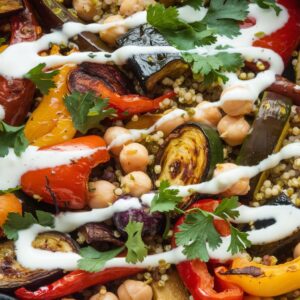Zungenzirkus is a unique term that may not be widely familiar, but it carries an interesting connotation. The word “zungenzirkus” is derived from the German language, combining “Zunge,” meaning tongue, and “Zirkus,” meaning circus. While this term can be interpreted in various ways, it is often used to describe playful, complex tongue movements or activities that involve a high level of skill and dexterity with the tongue. This can include linguistic exercises, speech therapy, or even culinary skills, such as mastering complex flavors or textures in cooking. In this article, we’ll explore the different facets of zungenzirkus, from its linguistic roots and cultural significance to its applications in speech therapy and culinary arts, particularly focusing on vegetarian recipes that delight the palate.
The Linguistic Roots of Zungenzirkus
To understand zungenzirkus, it’s essential to break down the term and explore its linguistic components. The word “Zunge” in German refers to the tongue, an organ that plays a crucial role in speech, taste, and oral health. The tongue is vital for articulating sounds and pronouncing words, making it a central element in language and communication. The term “Zirkus,” meaning circus, evokes images of performance, skill, and entertainment. When combined, zungenzirkus suggests an entertaining or skilled use of the tongue, which can encompass a range of activities from language games to culinary arts.
Zungenzirkus in Language and Speech Therapy
One of the most intriguing aspects of zungenzirkus is its application in language and speech therapy. Speech therapists often use tongue exercises to help individuals improve their speech clarity, articulation, and pronunciation. These exercises can be particularly beneficial for people with speech impediments, such as stuttering, lisping, or difficulty pronouncing certain sounds. In a therapeutic context, zungenzirkus involves a series of fun and engaging exercises that challenge the tongue’s agility and strength, helping to enhance speech skills over time.
For example, therapists might use tongue twisters, rhythmic exercises, or games that require precise tongue movements. These activities are designed to improve muscle control and coordination in the tongue, making it easier for individuals to articulate sounds correctly. In addition to speech therapy, zungenzirkus can also be a playful way for language enthusiasts to explore the nuances of pronunciation and accent, turning language learning into an enjoyable and interactive experience.
Culinary Zungenzirkus: A Circus of Flavors and Textures
Beyond its linguistic connotations, zungenzirkus can also refer to the art of creating complex flavors and textures in cooking. In this context, the tongue becomes a tool for exploring and enjoying a variety of tastes, from sweet and savory to spicy and bitter. Vegetarian cooking, in particular, offers a vibrant canvas for culinary zungenzirkus, allowing chefs to experiment with different ingredients, spices, and cooking techniques to create delicious and nutritious dishes.
Vegetarian Recipes: A Feast for the Tongue
Vegetarian cooking is a perfect example of zungenzirkus, as it requires creativity and skill to bring out the best flavors in plant-based ingredients. Let’s explore some vegetarian recipes that exemplify the concept of zungenzirkus, offering a delightful circus of flavors and textures for the palate.
- Spinach and Ricotta Tart: This savory tart combines the earthy flavor of spinach with the creamy richness of ricotta cheese. The addition of garlic, nutmeg, and a hint of lemon zest creates a harmonious blend of flavors that dance on the tongue. The flaky pastry crust adds a satisfying crunch, making this tart a perfect appetizer or light meal.
- Mushroom Risotto: A classic Italian dish, mushroom risotto is a testament to the art of zungenzirkus in cooking. The key to a good risotto lies in the gradual addition of broth, which allows the rice to absorb the liquid and develop a creamy texture. The earthy flavors of mushrooms, enhanced by a splash of white wine and a sprinkle of Parmesan cheese, create a symphony of tastes that delight the palate.
- Butternut Squash Soup: This velvety soup showcases the natural sweetness of butternut squash, complemented by the warmth of cinnamon and nutmeg. A swirl of coconut cream adds richness, while a sprinkle of toasted pumpkin seeds provides a delightful crunch. This soup is a perfect example of how simple ingredients can come together to create a complex and satisfying dish.
- Eggplant Parmesan: A vegetarian twist on a classic Italian favorite, eggplant Parmesan features layers of thinly sliced eggplant, marinara sauce, and melted mozzarella cheese. The eggplant is breaded and fried to a golden crisp, adding a delightful texture that contrasts with the smooth, tangy tomato sauce and gooey cheese. This dish is a true celebration of flavors and textures.
- Quinoa Salad with Roasted Vegetables: This colorful salad is a medley of roasted vegetables, such as bell peppers, zucchini, and cherry tomatoes, tossed with fluffy quinoa and a zesty lemon vinaigrette. The roasted vegetables add a smoky sweetness, while the quinoa provides a nutty flavor and satisfying chew. Fresh herbs like parsley and mint add a burst of freshness, making this salad a perfect light lunch or side dish.
- Stuffed Bell Peppers: Bell peppers are hollowed out and filled with a flavorful mixture of rice, black beans, corn, and spices. The peppers are then baked until tender, allowing the flavors to meld together. Topped with melted cheese and a dollop of sour cream, these stuffed peppers are a hearty and satisfying vegetarian meal.
- Lentil and Vegetable Curry: This aromatic curry is a perfect example of zungenzirkus in cooking, combining a variety of spices, such as cumin, coriander, and turmeric, to create a rich and flavorful sauce. The lentils add a hearty texture, while the vegetables, such as carrots, potatoes, and peas, provide a burst of color and flavor. Served with basmati rice or naan bread, this curry is a warming and satisfying dish.
- Zucchini Fritters: These crispy fritters are made with grated zucchini, mixed with flour, eggs, and a blend of herbs and spices. Fried to a golden brown, they have a crunchy exterior and a soft, flavorful interior. Served with a dollop of yogurt or a squeeze of lemon, these fritters make a delicious appetizer or snack.
- Caprese Salad: A simple yet elegant salad, Caprese combines ripe tomatoes, fresh mozzarella, and fragrant basil leaves, drizzled with olive oil and balsamic vinegar. The combination of sweet tomatoes, creamy cheese, and tangy vinegar creates a delightful contrast of flavors that is a true pleasure for the tongue.
- Chocolate Avocado Mousse: This decadent dessert is a perfect example of zungenzirkus in the culinary world. Creamy avocado is blended with cocoa powder, sweetened with honey or maple syrup, and flavored with a touch of vanilla. The result is a rich and silky chocolate mousse that is both indulgent and healthy, offering a unique twist on a classic dessert.
Zungenzirkus in Cultural Contexts
While zungenzirkus has practical applications in speech therapy and culinary arts, it also holds cultural significance. In many cultures, the tongue is associated with communication, taste, and expression. In Germany, where the term originates, the concept of zungenzirkus can be seen as a celebration of linguistic playfulness and culinary creativity. It’s a reminder that language and food are both forms of expression that bring people together, fostering connection and enjoyment.
In a broader cultural context, zungenzirkus can be understood as a metaphor for the art of juggling multiple tasks or skills with finesse and grace. Just as a circus performer entertains the audience with their agility and coordination, individuals who master the art of zungenzirkus demonstrate their ability to navigate the complexities of language, cooking, or other pursuits with ease and confidence.
Practical Tips for Mastering Zungenzirkus
Whether you’re interested in improving your speech skills, enhancing your cooking techniques, or simply exploring the concept of zungenzirkus, there are several practical steps you can take to master this unique art.
Practice Tongue Exercises:
To improve your speech clarity and pronunciation, try incorporating tongue exercises into your daily routine. Simple exercises, such as tongue twisters, humming, or rolling your tongue, can help strengthen the muscles in your tongue and improve your articulation.
Experiment with Flavors:
In the kitchen, don’t be afraid to experiment with different flavors and ingredients. Try combining sweet and savory, spicy and tangy, or crunchy and creamy to create a delightful zungenzirkus of tastes and textures.
Engage in Language Games:
Language games, such as word puzzles, riddles, or storytelling, can be a fun way to explore the nuances of pronunciation and accent. These games challenge your tongue to perform complex movements, helping you improve your language skills in a playful and engaging way.
Explore Vegetarian Cooking:
If you’re new to vegetarian cooking, start by experimenting with simple recipes that showcase the natural flavors of vegetables and plant-based ingredients. As you gain confidence, try more complex dishes that require skill and creativity, turning your kitchen into a zungenzirkus of culinary delights.
Celebrate Cultural Diversity:
Embrace the cultural significance of zungenzirkus by exploring different languages, cuisines, and traditions. Whether you’re learning a new language or trying a new recipe, take the time to appreciate the beauty and complexity of these diverse forms of expression.
The Future of Zungenzirkus
As the world becomes increasingly interconnected, the concept of zungenzirkus is likely to continue evolving. In a globalized society, where language and culture intersect in new and exciting ways, the art of zungenzirkus can serve as a bridge, fostering communication, understanding, and creativity across borders. Whether through language learning, culinary exploration, or cultural exchange, zungenzirkus reminds us of the joy and richness that comes from mastering the art of expression.
Conclusion
Zungenzirkus is a German term meaning “tongue circus.” It describes skilled or playful tongue movements, often used in speech therapy, language learning, or cooking. In speech therapy, it involves exercises to improve pronunciation and articulation. In cooking, it refers to creating complex flavors and textures, particularly in vegetarian dishes. The concept celebrates creativity and dexterity in language and culinary arts.
FAQs
1 – What does zungenzirkus mean?
Zungenzirkus is a German term that combines “Zunge” (tongue) and “Zirkus” (circus). It refers to skilled or playful tongue movements, which can be applied in language learning, speech therapy, or culinary arts.
2 – How is zungenzirkus used in speech therapy?
In speech therapy, zungenzirkus involves exercises that improve tongue agility and strength, helping individuals articulate sounds more clearly and effectively.
3 – Can zungenzirkus be related to cooking?
Yes, zungenzirkus can also refer to the art of creating complex flavors and textures in cooking, particularly in vegetarian cuisine, where chefs use a variety of ingredients and techniques to delight the palate.
4 – What are some examples of zungenzirkus exercises?
Examples include tongue twisters, humming exercises, and games that require precise tongue movements, all designed to improve speech clarity and pronunciation.




